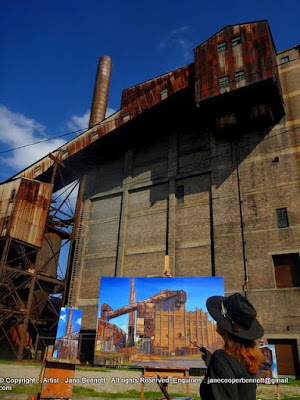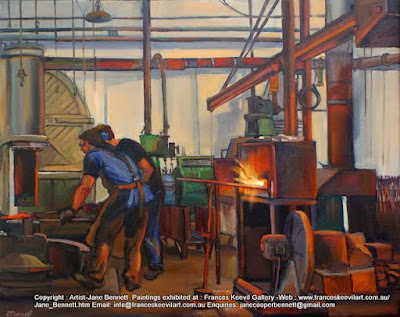Designer + Blacksmith = The Collaborative Effect
This event, coordinated by Alain-Henri Chazelles of IN HOUSE GROUP3, brought designer Alex Ritchie, (Creative
Director of experiential design agency E2) and metalworker Guido Gouverneur (Blacksmith and Metalworker of Wrought Artworks and Steel
Windows and Doors), together to discuss forged iron and conceptually
designed architectural metalwork in the built environment.
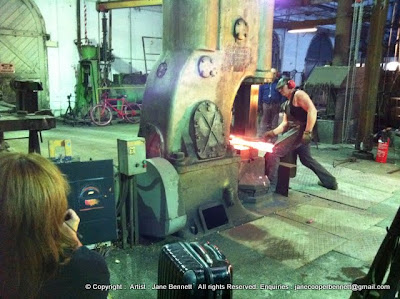 |
| Jane Bennett, industrial heritage artist, painting the blacksmiths of 'Wrought Artworks' Australian Technology Park, Eveleigh Railway Workshops |
Guido and his team of blacksmiths also gave an exciting forging
demonstration.
 |
| Jane Bennett, industrial heritage artist painting the blacksmiths of 'Wrought Artworks' Australian Technology Park Eveleigh Railway Workshops |
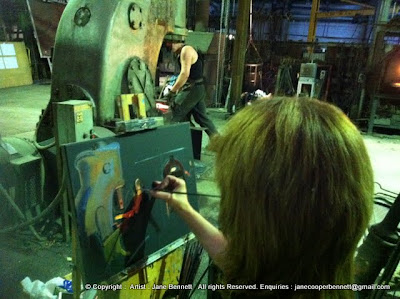 |
| Jane Bennett, industrial heritage artist painting the blacksmiths of 'Wrought Artworks' Australian Technology Park Eveleigh Railway Workshops |
I also gave a demonstration of how I paint fast-moving
artisans working in darkness, while attempting to dodge the twirling
batons of red-hot metal that they waved around with such nonchalant grace.
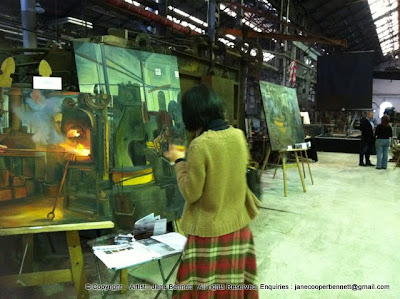 |
| Exhibition by Jane Bennett, industrial heritage artist, painting the blacksmiths of 'Wrought Artworks' Australian Technology Park Eveleigh Railway Workshops |
I exhibited a selection of my paintings of the Blacksmiths of Wrought Artworks as well as paintings of the fascinating interior and Victorian era heritage industrial machinery of the site.
One of the great drawcards of the ATP has been the continual operation of Blacksmith’s shop in Bays 1 & 2 South at the ATP. From the very beginning it has been seen as maintaining a link to the buildings industrial past. The construction of the ATP had even included the erection of an acoustic wall so that the workshop could continue to function close to the new occupants. However the existance of the Blacksmith's shop was threatened when the Redfern Waterloo Authority served them with a notice to quit by the 30th September 2008. After a successful campaign and Open Day the RWA and the Blacksmiths then signed a Lease that preserved the operating Blacksmiths and recognised the vital importance of heritage preservation in the operations of the Technology Park.
See the history of the campaign to save the blacksmith :
Redwatch "ATP's operating Blacksmith"
One of the great drawcards of the ATP has been the continual operation of Blacksmith’s shop in Bays 1 & 2 South at the ATP. From the very beginning it has been seen as maintaining a link to the buildings industrial past. The construction of the ATP had even included the erection of an acoustic wall so that the workshop could continue to function close to the new occupants. However the existance of the Blacksmith's shop was threatened when the Redfern Waterloo Authority served them with a notice to quit by the 30th September 2008. After a successful campaign and Open Day the RWA and the Blacksmiths then signed a Lease that preserved the operating Blacksmiths and recognised the vital importance of heritage preservation in the operations of the Technology Park.
See the history of the campaign to save the blacksmith :
Redwatch "ATP's operating Blacksmith"
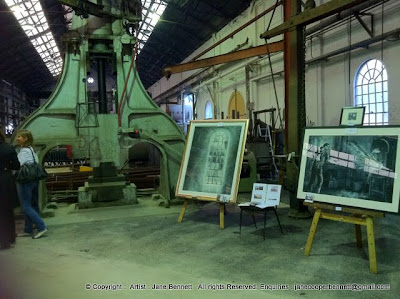 |
| Exhibition by Jane Bennett, industrial heritage artist, painting the blacksmiths of 'Wrought Artworks' Australian Technology Park, Eveleigh Railway Workshops |
The photos of me in action were taken by Frances Keevil, the Director of the Frances Keevil Gallery.
 | |
| E83 'Blacksmith forging ' 2011 ink pastel acrylic on paper 9 x 10cm WINNER 2nd Prize for Miniature Painting 2011 Royal Easter Show Enquiries |
 |
| E64 The Blacksmith 2011 oil on canvas 75x100cm Enquiries |
Next year, for a single day on Saturday 25th February 2012, the whole Australian Technology Park will be open to the public.
There will be another forging demonstration and I will have an even larger exhibition of paintings, as well as giving a demonstration of painting the heritage interiors and the blacksmiths.


